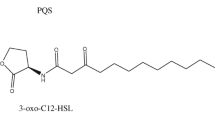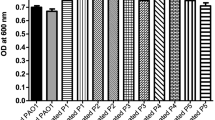Abstract
Pseudomonas aeruginosa coordinates the secretion of virulence factors through quorum sensing. Quorum sensing inhibitors can attenuate the pathogenesis of bacteria and help the immune system to eradicate them without targeting the bacterial growth. This study aimed to explore the anti-quorum sensing and anti-virulence activities of sitagliptin against P. aeruginosa PAO1 strain. Sub-inhibitory concentration of sitagliptin significantly inhibited the virulence factors pyocyanin, hemolysin, protease and elastase in addition to blocking swimming, swarming and twitching motilities and biofilm formation. In silico analysis showed that sitagliptin interacted with LasR receptors by hydrogen bonding and hydrophobic interaction, mainly with the amino acids leucine present at positions 40 and 125, tyrosine at position 56, serine at position 129, tryptophan at position 60, alanine at position 50 and phenyl alanine at position 101. qRT-PCR confirmed the anti-quorum sensing activity by reducing the expression level of QS genes lasI, lasR, rhlI, rhlR, pqsA and pqsR. In conclusion, sitagliptin is a novel anti-quorum sensing agent that can be used for treating P. aeruginosa infections.





Similar content being viewed by others
References
Livermore DM (2011) British society for antimicrobial chemotherapy working party on the urgent need: regenerating antibacterial drug discovery and development. Discovery research: the scientific challenge of finding new antibiotics. J Antimicrob Chemother 66:1941–1944
Wu H, Moser C, Wang HZ, Høiby N et al (2015) Strategies for combating bacterial biofilm infections. Int J Oral Sci 7:1–7
Chong YM, Yin WF, Ho CY et al (2010) Malabaricone C from Mysrista cinnamomea exhibit anti-quorum sensing activity. J Nat Prod 74:2261–2264
Costerton JW (2001) Cystic fibrosis pathogenesis and the role of biofilms in persistent infection. Trends Microbiol 9:50–52
Van Delden C, Iglewski BH (1998) Cell-to-cell signaling and Pseudomonas aeruginosa infections. Emerg Infect Dis 4:551–560
Gaynes R, Edwards JR (2005) National Nosocomial Infections Surveillance S. Overview of nosocomial infections caused by gram-negative bacilli. Clin Infect Dis 41:848–854
Anwar H, Dasgupta MK, Costerton JW (1990) Testing the susceptibility of bacteria in biofilms to antibacterial agents. Antimicrob Agents Chemother 34:2043–2046
Juhas M, Eberl L, Tummler B (2005) Quorum sensing: the power of cooperation in the world of Pseudomonas. Environ Microbiol 7:459–471
Rasmussen TB, Givskov M (2006) Quorum-sensing inhibitors as anti-pathogenic drugs. Int J Med Microbiol 296:149–161
Winzer K, Williams P (2001) Quorum sensing and the regulation of virulence gene expression in pathogenic bacteria. Int J Med Microbiol 291:131–143
Gambello MJ, Kaye S, Iglewski BH (1993) LasR of Pseudomonas aeruginosa is a transcriptional activator of the alkaline protease gene (apr) and an enhancer of exotoxin A expression. Infect Immun 61:1180–1184
Hentzer M, Wu H, Andersen JB et al (2003) Attenuation of Pseudomonas aeruginosa virulence by quorum sensing inhibitors. EMBO J 22:3803–3815
Smith RS, Iglewski BH (2003) P. aeruginosa quorum-sensing systems and virulence. Curr Opin Microbiol 6:56–60
Kiratisin P, Tucker KD, Passador L (2002) LasR, a transcriptional activator of Pseudomonas aeruginosa virulence genes, functions as a multimer. J Bacteriol 184:4912–4919
Schuster M, Urbanowski ML, Greenberg EP (2004) Promoter specificity in Pseudomonas aeruginosa quorum sensing revealed by DNA binding of purified LasR. Proc Natl Acad Sci USA 101:15833–15839
Winson MK, Camara M, Latifi A et al (1995) Multiple N-acyl-L-homoserine lactone signal molecules regulate production of virulence determinants and secondary metabolites in Pseudomonas aeruginosa. Proc Natl Acad Sci USA 92:9427–9431
Davies DG, Parsek MR, Pearson JP et al (1998) The involvement of cell-to-cell signals in the development of a bacterial biofilm. Science 280:295–298
Hentzer M, Riedel K, Rasmussen TB et al (2002) Inhibition of quorum sensing in Pseudomonas aeruginosa biofilm bacteria by a halogenated furanone compound. Microbiology 148:87–102
Persson T, Givskov M, Nielsen J (2005) Quorum sensing inhibition: targeting chemical communication in gram negative bacteria. Curr Med Chem 12:3103–3115
Venturi V (2006) Regulation of quorum sensing in Pseudomonas. FEMS Microbiol Rev 30:274–291
Heeb S, Fletcher MP, Chhabra SR et al (2011) Quinolones: from antibiotics to autoinducers. FEMS Microbiol Rev 35:247–274
Lee J, Wu J, Deng Y et al (2013) A cell-cell communication signal integrates quorum sensing and stress response. Nat Chem Biol 9:339–343
Abbas HA (2015) Inhibition of virulence factors of Pseudomonas aeruginosa by diclofenac sodium. Roum Arch Microbiol Immunol 74(3–4):79–85
Abbas HA, Shaldam MA (2016) Glyceryl trinitrate is a novel inhibitor of quorum sensing in Pseudomonas aeruginosa. Afr Health Sci 16(4):1109–1117
Abbas HA, Elsherbini AM, Shaldam MA (2017) Repurposing metformin as a quorum sensing inhibitor in Pseudomonas aeruginosa. Afr Health Sci 17(3):808–819
Das T, Manefield M (2012) Pyocyanin promotes extracellular DNA release in Pseudomonas aeruginosa. PLoS ONE 7:e46718
Kim D, Wang L, Beconi M et al (2005) (2R)-4-oxo-4-[3-(trifluoromethyl)-5,6 dihydro[1,2,4]triazolo[4,3-a]pyrazin-7(8H)-yl]-1-(2,4,5-trifluorophenyl) butan-2-amine: a potent, orally active dipeptidyl peptidase IV inhibitor for the treatment of type 2 diabetes. J Med Chem 48:141–151
Hema M, Vasudevan S, Balamurugan P et al (2017) Modulating the global response regulator, LuxO of V. cholerae Quorum Sensing System using a pyrazine dicarboxylic acid derivative (PDCApy): an antivirulence approach. Front Cell Infect Microbiol 7:441
Zhang B, Guo B, Bai Y et al (2018) Synthesis and biological evaluation of azamacrolide comprising the triazole moiety as quorum sensing inhibitors. Molecules 23:1086
Clinical and Laboratory Standards Institute (2012) Methods for dilution antimicrobial susceptibility tests for bacteria that grow aerobically; Approvated standard, CLSI Document M07-A9, Vol. 32, No. 3. Wayne, PA, USA
Nalca Y, Jansch L, Bredenbruch F et al (2006) Quorum-sensing antagonistic activities of azithromycin in Pseudomonas aeruginosa PAO1: a global approach. Antimicrob Agents Chemother 50:1680–1688
Stepanovic S, Vukovic D, Hola V et al (2007) Quantification of biofilm in microtiter plates: overview of testing conditions and practical recommendations for assessment of biofilm production by staphylococci. APMIS 115(8):891–899
Vijayaraghavan P, Vincent SGP (2013) A simple method for the detection of protease activity on agar plate using bromocresolgreen dye. J Biochem Technol 4(3):628–630
Ohman DE, Cryz SJ, Iglewski BH (1980) Isolation and characterization of a P. aeruginosa PAO1 mutant that produces altered elastase. J Bacteriol 142:836–884
Rossignol G, Merieau MA, Guerillon J et al (2008) Involvement of a phospholipase C in the hemolytic activity of a clinical strain of Pseudomonas fluorescens. BMC Microbiol 8:189
Rashid MH, Kornberg A (2000) Inorganic polyphosphate is needed for swimming, swarming, and twitching motilities of Pseudomonas aeruginosa. Proc Natl Acad Sci USA 97(9):4885–4890
Kinscherf TG, Willis DK (1999) Swarming by Pseudomonas syringae B728a requires gacS (lemA) and gacA but not the acyl-homoserine lactone biosynthetic gene ahlI. J Bacteriol 181:4133–4136
Krishnan T, Yin W, Chan K (2012) Inhibition of quorum sensing-controlled virulence factor production in P. aeruginosa PAO1 by Ayurveda spice clove (Syzygium aromaticum). Bud Extr Sens (Basel) 12:4016–4030
El-Mowafy SA, Abd El Galil KH, El-Messery SM et al (2014) Aspirin is an efficient inhibitor of quorum sensing, virulence and toxins in Pseudomonas aeruginosa. Microb Pathog 74:25–32
Livak KJ, Schmittgen TD (2001) Analysis of relative gene expression data using real-time quantitative PCR and the 2(-Delta Delta C(T)) Method. Methods 25:402–408
Bottomley MJ, Muraglia E, Bazzo R, Carfì A (2007) Molecular insights into quorum sensing in the human pathogen Pseudomonas aeruginosa from the structure of the virulence regulator LasR bound to its autoinducer. J Biol Chem 282:13592–13600
Galloway WR, Hodgkinson JT, Bowden S et al (2012) Applications of small molecule activators and inhibitors of quorum sensing in Gram-negative bacteria. Trends Microbiol 20:449–458
Jakobsen TH, Bjarnsholt T, Jensen PØ et al (2013) Targeting quorum sensing in Pseudomonas aeruginosa biofilms: current and emerging inhibitors. Future Microbiol 7:901–921
Arafa NAS, Amin GEE (2010) The epidemiology of diabetes mellitus in Egypt: Results of a National Survey. Egypt J Commun Med 28(3):29–43
Shaw JE, Sicree RA, Zimmet PZ (2010) Global estimates of the prevalence of diabetes for 2010 and 2030. Diabetes Res Clin Pract 87(1):4–14
Pecoraro RE, Reiber GE, Burgess EM (1990) Pathways to diabetic limb amputation: basis for prevention. Diabetes Care 13(5):513–521
Reiber GE (1996) The epidemiology of diabetic foot problems. Diabetes Med 13(1):S6–11
Reiber GE, Vileikyte L, Boyko EJ et al (1999) Causal pathways for incident lower-extremity ulcers in patients with diabetes from two settings. Diabetes Care 22(1):157–162
Wrobel JS, Mayfield JA, Reiber GE (2001) Geographic variation of lower-extremity major amputation in individuals with and without diabetes in the Medicare population. Diabetes Care 24(5):860–864
Bansal E, Garg A, Bhatia S et al (2008) Spectrum of microbial flora in diabetic foot ulcers. Ind J Pathol Microbiol 51(2):204–208
Gupta RK, Setia S, Harjai K (2011) Expression of quorum sensing and virulence factors are interlinked in P. aeruginosa: an in vitro approach. Am J Biomed Sci 3:116–125
Glessner A, Smith RS, Iglewski BH et al (1999) Roles of P. aeruginosa las and rhl quorum-sensing systems in control of twitching motility. J Bacteriol 181:1623–1629
Heydorn A, Ersboll B, Kato J et al (2002) Statistical analysis of P. aeruginosa biofilm development: impact of mutations in genes involved in twitching motility, cell-to-cell signalling, and stationary-phase sigma factor expression. Appl Environ Microbiol 68:2008–2017
Sonia TA, Sharma CP (2014) Diabetes mellitus—an overview. Oral delivery of insulin. Woodhead Publishing Series in Biomedicine, Cambridge, pp 1–57
Author information
Authors and Affiliations
Contributions
HA: Conceptualization, methodology, investigation, reviewing and editing, supervision; DE: Methodology, writing original draft preparation; MS: In silico methodology, writing original draft preparation.
Corresponding author
Ethics declarations
Conflict of interest
The authors declare that they have no conflict of interest.
Additional information
Publisher's Note
Springer Nature remains neutral with regard to jurisdictional claims in published maps and institutional affiliations.
Electronic Supplementary Material
Below is the link to the electronic supplementary material.
Rights and permissions
About this article
Cite this article
Abbas, H.A., Shaldam, M.A. & Eldamasi, D. Curtailing Quorum Sensing in Pseudomonas aeruginosa by Sitagliptin. Curr Microbiol 77, 1051–1060 (2020). https://doi.org/10.1007/s00284-020-01909-4
Received:
Accepted:
Published:
Issue Date:
DOI: https://doi.org/10.1007/s00284-020-01909-4




